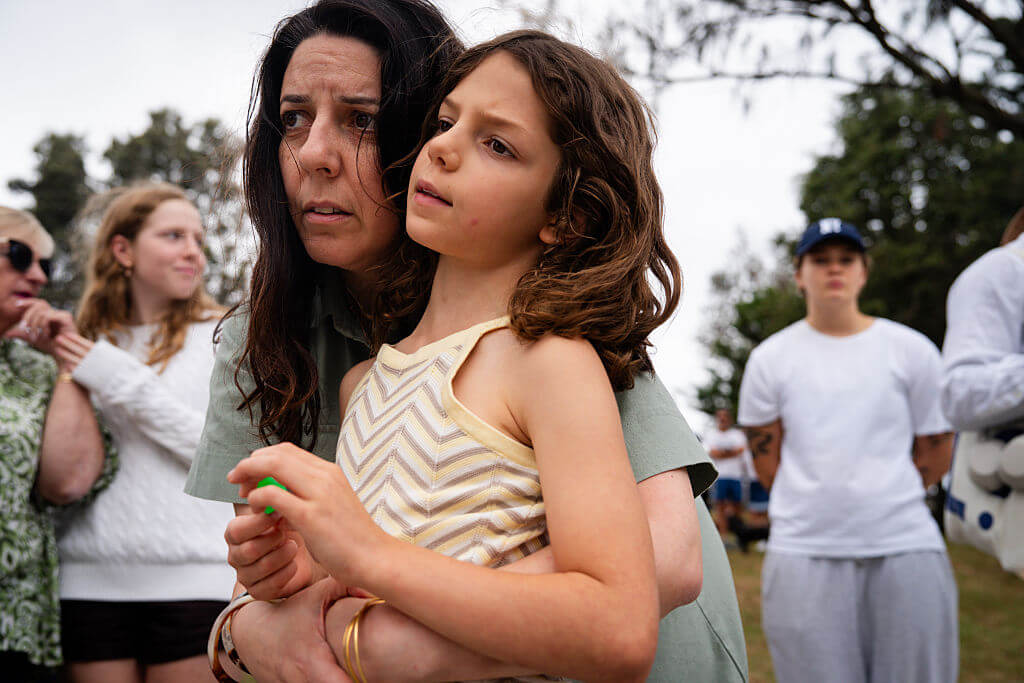Weaving Together a Family’s History, One Thread at a Time
Your life is like a Tapestry
Being Woven by G-d and History
On an Enchanted Loom. Every
Bobble of the shuttle has meaning;
Every thread is important.
— Richard Nelson Bolles (b.1927)
I am sitting in the weaving room of the Jewish Community Center in Wilkes-Barre, Pa. Outside, the Susquehanna River is rolling past, deep and rough and dusty sage-blue. Church bells ring out the hymn of Grace Before Meals. “Evening is here, come bow your head, we thank you Lord for this good bread. Aaamen….” Upstairs, four women are re-creating a scene from the times of the Bible; weaving talleisim, prayer shawls that were worn, as far as we know, back in the time of the First and Second Temples. Thick wool is being spooled for the yarn, with colors reminiscent of ancient spices displayed on the shelves: regal purple, sapphire, copper…. On the wall to my right is a long list — four lines black, one line gold, two lines black, one line gold, 1/2-inch ivory, four lines gold — which my daughter Shira and I are following and checking off as we throw each shuttle, beat down with the reed and change each shed.
I have chosen to duplicate the pattern on my husband’s grandfather’s tallis. For me, the black and gold stripes against ivory evoke a traditional Old World feeling. The tallis is being woven for our son, Benjamin, in honor of his bar mitzvah at Congregation Ramath Orah in New York City.
Four lines of gold, 1 inch of ivory, four lines of gold, four lines of ivory, four lines of black….
Three wooden looms stand in separate areas of the room; one loom is being warped — with 20 spools of white threads twisted over a silver bar near the ceiling. My mother was born and raised just outside Wilkes-Barre, a former coal-mining town of 40,000 at the western edge of the Poconos. My cousins, aunts and uncles still live here, and I return often to stay close to them, and to her memory. The Jewish community here is tiny, just 3,500 souls, but strong. The JCC houses the only tallis-weaving program left in the United States.
Steve Nachlis, the director of the weaving program, is warping the loom. This entails beaming the threads from their spools into 26 metal sections of a sectional beam. Then 520 strings are threaded individually into heddles and then threaded again, one at a time, into a single metal reed. Each string is then tied onto an apron, and that becomes your warp. With these organic apparatus, an ambience of another era is summoned up. In addition, an intangible energy gets created around the space of the weaver, a spiritual and invisible magnetic field. Like the air in an old synagogue; it inherits the yearning of the people that pray there. It settles into the benches, into the curled edges of the prayer books.
Four lines of ivory, four lines of black, four lines of ivory, four lines of gold. A timeless sensation settles over me as I shoot the shuttle and beat down another woolen line of gold. Switch feet, beat down, reverse the pedals. My thoughts quiet down to that unspoken place. A place of emerald green, blue knight and pastel blue….
“It’s because we are not multitasking,” says my aunt, Esther Davidowitz. “It’s a luxury in today’s world to be able to just do one thing. One thing at a time.” Tanta Esther is at the loom across from me, weaving a tallis for her grandson, Daniel. Her colors are royal blue and silver, and Daniel wants a tree woven onto the back. The Tree of Life is a symbol to him, an important metaphor, as it had been to his grandfather.
Four lines of gold. 3 inches of ivory. Tanta Esther is weaving her 18th tallis. One man had a son in the army, and he made a deal with God: If God sent his son home alive, he would devote his life to holy deeds. The man’s son did come home alive and the man did exactly what he promised. Tanta Esther had woven him an ivory-and-golden tallis. Four lines of ivory. Six lines of gold.
On the second day, Shira, who is 14, begins to suspect that something is wrong. We are already at the section that will be 37 inches of ivory for the back. Shira’s nose is practically touching the loom; something is not matching. The ivory
color we have been using all along looks white. “Florence!” we call out to Florence Kornblatt, who had been the head of the program years ago and now volunteers endless hours of her time. She tightens threads that loop out over the edge, sews in loops that are too intertwined to save and lets my “bloopers” stay because, as Tanta Esther says, “Life isn’t perfect and neither is the tallis.”
“We’re in trouble,” I say. Florence rushes over, announcing, “There’s nothing that you can do that I cannot undo.”
She snips off a piece and then runs to the shelves to match the white thread. “This is the thread from the warp,” Florence says. We had accidentally spooled the warp’s wool for our shuttle. Thank God Shira caught this subtle difference after only 2 inches of weaving.
“Der Aybishter Shlauft Nisht,” Florence says, spooling the correct ivory wool. “The Almighty sleeps not.” I am in awe of her tireless good will. We have been here since 10 a.m., and it is now almost 4 p.m. “I come here because I want to, ketzele (little kitten). To me this is sacred work.”
Four lines of ivory. One line of gold. Four lines of ivory. One line of gold. Our tallis starts to remind me of the gold on ivory that Tanta Esther wove for the holy man.
“Eighteenth tallis,” I say to Tanta Esther. “This is a good-luck tallis.”
Eighteen is, of course, the numerical equivalent for the Hebrew word Chai, signifying life, and it is a number associated with good fortune.
The afternoon begins to wane. It is the end of the second day. We will finish our work tomorrow. The river sinks low, meandering more slowly. Midnight-blue light exudes from the water as it flows under the great stone archways of the Market Street Bridge. A Russian boy begins to practice his French horn in a room next door, blasting the scales through the wall.
“Eighteen,” I repeat to Tanta Esther. “This tallis symbolizes life. This tallis is a good-luck tallis.”
Shira walks over. “It’s beautiful,” she says, bending over the shining silver.
“Pooh, pooh, pooh,” Florence purses her lips to ward off the evil spirits.
Tanta Esther smiles with that benign quality one acquires after praying in an old synagogue. As if she is answering us without having to answer, “I know, dear, I know.”















